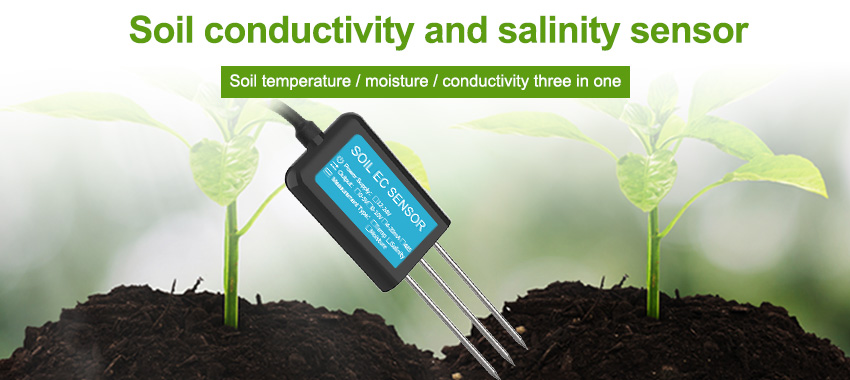Soil temperature and humidity play crucial roles in the growth and development of plants, as well as in various environmental processes. Monitoring these parameters is essential for agricultural management, ecological research, and land use planning. Soil temperature and humidity sensors are valuable tools that provide real-time data for understanding soil dynamics. In this article, we will explore the significance of soil temperature and humidity sensors in soil monitoring, discussing their functions, applications, and impact on agriculture and environmental sustainability.

Functions of Soil Temperature and Humidity Sensors:
Soil temperature and humidity sensors are designed to measure the thermal and moisture conditions of the soil. These sensors are typically buried at specific depths to capture accurate readings that reflect the soil profile. The functions of soil temperature and humidity sensors include:
Monitoring Soil Temperature:
Soil temperature sensors measure the heat energy within the soil. They provide data on diurnal and seasonal temperature variations, which influence biological processes such as seed germination, root growth, and microbial activity. By tracking soil temperature, farmers and researchers can make informed decisions about planting times, crop selection, and irrigation scheduling.
Assessing Soil Moisture Content:
Soil humidity sensors quantify the amount of water present in the soil. They detect changes in soil moisture levels caused by precipitation, evaporation, and plant water uptake. Monitoring soil moisture content is critical for optimizing irrigation practices, preventing waterlogging or drought stress, and conserving water resources.
Types of Soil Temperature and Humidity Sensors:
There are various types of sensors used for measuring soil temperature and humidity, each with its own principles of operation and applications.
Resistance-based Sensors:
These sensors use the principle of electrical resistance to measure soil temperature and moisture. Changes in resistance due to temperature or moisture variations are converted into corresponding sensor outputs.
Capacitance Sensors:
Capacitance-based sensors estimate soil moisture content by measuring the dielectric properties of the soil. They are sensitive to both water and temperature, providing valuable multi-parameter data.
Thermocouple Sensors:
Thermocouples consist of two dissimilar metal wires joined at one end. They generate a voltage proportional to the temperature difference between the junction and the free ends, allowing for accurate soil temperature measurements.
Time Domain Reflectometry (TDR) Sensors:
TDR sensors send electromagnetic pulses into the soil and measure the time it takes for the pulses to travel through the soil. This method provides precise soil moisture measurements based on the soil’s dielectric properties.
Applications of Soil Temperature and Humidity Sensors:
Soil temperature and humidity sensors have diverse applications across different fields, including agriculture, environmental science, and engineering.
Precision Agriculture:
In precision agriculture, soil sensors are used to optimize irrigation and fertilizer application, leading to improved crop yields and resource efficiency. Real-time data from soil sensors helps farmers make timely decisions to enhance crop health and productivity.
Environmental Monitoring:
Ecologists and environmental scientists utilize soil sensors to study soil-plant interactions, assess ecosystem health, and investigate climate change impacts on soil dynamics. Long-term monitoring with soil sensors provides valuable data for ecological modeling and conservation efforts.
Land Use Planning:
Soil temperature and humidity data contribute to land use planning by informing decisions related to urban development, infrastructure design, and natural resource management. Understanding soil conditions supports sustainable land use practices and resilience in the face of environmental challenges.
Impact on Agricultural Sustainability:
The integration of soil temperature and humidity sensors in agricultural practices has significant implications for sustainability and resource management.
Water Conservation:
By precisely monitoring soil moisture levels, farmers can implement efficient irrigation strategies that minimize water waste and reduce environmental impact. Optimal soil moisture management contributes to water conservation and drought resilience in agricultural systems.
Energy Efficiency:
Accurate soil temperature data allows for better timing of planting and crop management activities, leading to energy savings and reduced reliance on intensive farming practices. Energy-efficient agriculture promotes environmental stewardship and economic viability for farmers.
Yield Optimization:
Soil sensors enable farmers to tailor their cultivation practices to suit the specific needs of their crops, resulting in higher yields and improved product quality. Enhanced crop performance supports food security and economic sustainability in agricultural communities.

Conclusion
Soil temperature and humidity sensors are indispensable tools for soil monitoring, providing critical data for agricultural decision-making, environmental research, and land use planning. These sensors offer insights into soil thermal and moisture dynamics, enabling stakeholders to optimize resource utilization, enhance ecosystem resilience, and promote sustainable agriculture. By harnessing the power of soil sensors, we can advance our understanding of soil-plant interactions and contribute to the long-term health and productivity of our lands.